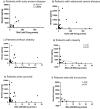Pre-existing adipose tissue signaling profile related to obesity determines disease outcome of COVID-19: addressing obesity should be a priority for future pandemic preparedness
- PMID: 40352457
- PMCID: PMC12061698
- DOI: 10.3389/fendo.2025.1506065
Pre-existing adipose tissue signaling profile related to obesity determines disease outcome of COVID-19: addressing obesity should be a priority for future pandemic preparedness
Abstract
Objectives: Obesity is associated with COVID-19 severity and mortality. We investigated relationships between adipokines, cytokines and redox parameters with obesity, human immunodeficiency virus (HIV), severity and outcome.
Methods: In the exploratory study, adipose tissue (AT) was sampled in patients with COVID-19 on admission. Concentrations of leptin, adiponectin, resistin, interleukin 1 beta (IL-1b), IL-2, IL-6, IL-10, IL-17, tumor necrosis factor alpha (TNF-a), monocyte chemoattractant protein 1 (MCP-1), Trolox equivalent antioxidant capacity (TEAC), oxidative stress (H202) and malonaldehyde (MDA) were determined.
Results: Thirty-eight biopsies of subcutaneous adipose tissue were obtained (prevalence of HIV was 39% and of obesity 61%). Higher IL-6 serum concentrations (p=0.03) were associated with more severe COVID-19, and higher serum IL-10 concentrations, (p=0.03) with mortality. People with obesity had higher leptin concentrations (p=0.03, and p<0.01), lower adiponectin/leptin (p=0.03 and p<0.01), and higher leptin/resistin ratios (p=0.09 and p<0.01) in both AT and serum respectively. Higher leptin/resistin (p=0.04) and lower adiponectin/resistin (p=0.05) ratios in AT, but not serum, were predictive of mortality. HIV was not associated with any differences. Relationships between resistin and redox indicators, TEAC and MDA, suggest a dysregulation of metabolic vs immune-relevant effect of resistin, which differentially predicted severity and mortality. SARS-CoV-2 RNA was detected in the subcutaneous AT in 3/8 patients who demised, but only in 1/30 who survived.
Conclusion: Given the significant link demonstrated between leptin dysregulation in obesity and mortal severity of COVID-19, addressing obesity should be a priority therapeutic target in terms of future pandemic preparedness. Mechanistic studies are recommended to further elucidate the importance of metabolic vs immune modulation by resistin in COVID-19, to identify future therapeutic targets.
Keywords: COVID-19; HIV; adipokine; adiponectin; adipose tissue; leptin; obesity; resistin.
Copyright © 2025 Parker, Petersen-Ross, Maponga, Parkar, Ahmed, Snyders, Kidd, Taljaard, Meintjes, Koegelenberg, Kleynhans and Smith.
Conflict of interest statement
The authors declare that the research was conducted in the absence of any commercial or financial relationships that could be construed as a potential conflict of interest.
Figures



References
-
- Gao M, Piernas C, Astbury NM, Hippisley-Cox J, O’Rahilly S, Aveyard P, et al. . Associations between body-mass index and COVID-19 severity in 6·9 million people in England: a prospective, community-based, cohort study. Lancet Diabetes Endocrinol. (2021) 9:350–9. doi: 10.1016/S2213-8587(21)00089-9 - DOI - PMC - PubMed
-
- Parker A, Boloko L, Moolla MS, Ebrahim N, Ayele BT, Broadhurst AGB, et al. . Clinical features and outcomes of COVID-19 admissions in a population with a high prevalence of HIV and tuberculosis: a multicentre cohort study. BMC Infect Dis. (2022) 22. doi: 10.1186/s12879-022-07519-8 - DOI - PMC - PubMed
MeSH terms
Substances
LinkOut - more resources
Full Text Sources
Medical
Research Materials
Miscellaneous

